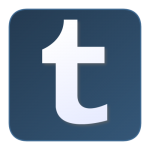by Lili Petkova
| May 18, 2012
 Pros and cons of some of the most popular blogging platforms
Pros and cons of some of the most popular blogging platforms
In one of our previous posts we’ve already covered the topic of choosing the best blogging platform by comparing well-known software by comparing WordPress, Bosinglogger and SquareSpace. Let’s check out some other, different blogging platforms. They’re the most popular of the so called “micro-blogging platforms”. The micro-blog typically has smaller content than the regular one – it can be just one sentence, an image or a video link.
Tumblr

The well-known platform for micro-blogging – Tumblr, is focused on short and frequent posts. It’s somewhere in between writing in a blog and posting to Twitter. Using Tumblr you can expand the content that you share on social networks and drive some extra traffic to your website.
Pros
- Easy-to-use. Tumblr is really simple – with a few clicks you can upload photos, text, images, and audio and video in short, quick posts or lengthier ones. Setting up and customizing is easy too and you can start blogging a few minutes after you sign in.
- Option for audio blogging. Tumblr comes with many outstanding and interesting features like free custom domains.
- Community. Tumblr’s community shares a lot of content and the users interact with each other – the reason that some people call it a social network, not a blogging platform. If your business is relevant to Tumblr’s users, you can create content that they will share and it may well spread to a lot more people than you intended at the beginning.
- You can use content, created by others. Just because Tumblr has some characteristics of a social network, you don’t have to constantly create your own content. You can share items related to your business content that others will enjoy. This way you’re indirectly informing potential customers of your business and you stay in touch with them.
- Links with social networks and third-party apps. You can sync your Tumblr account with Facebook and/or Twitter so that you can update your social media feeds in a single location. Tumblr also offers support for many third-party apps such as Google Analytics.
Cons
- Not so customizable. The point is that bloggers focus more on the content itself. Compared to other platforms the list of themes is quite short. You can upload your own picture and set it up as a theme though. There is a list of premium themes, but they’re paid.
- Sacrificing some freedom. You don’t have so much control over formatting of your posts, themes and other options – freedom that the more advanced platforms offer.
- Not so good mobile applications. There are a lot of mobile apps for Tumblr which you can use on your device. But it seems that every one of them is missing something. The official Tumblr app is not so well developed – some of the other apps offer more functionality than it does. So posting on-the-go is not as easy as it should be.
Posterous Spaces

Posterous Spaces is another popular micro-blogging platform that is a social network as well. It’s really similar to Tumblr and in spite of some differences between them you can achieve the same goals and results for your business with either platform. Which one you choose is really a matter of your own personal taste and feelings about the platforms. Posterous can also be integrated with your business Twitter profile and Facebook page.
Pros
- There’s nothing short about your posts. Despite the fact that it’s a micro-blogging platform, you can write posts that are as long as you wish, with attached images and video.
- Advanced email-based blogging. It’s not an option that everyone uses or likes, but you can do almost the same thing as posting, by yourself, with a single e-mail – attaching images, videos etc.
- Excellent control over privacy. You can create “spaces” for people to follow. You set up permissions for every space, so that you can choose who can read your posts. For example you can have a space for public posts, for your private blog, or for a group of your loyal customers.
- Free mobile apps for iOS and Android. You can post easily on-the-go and your blog has a mobile-friendly version, so when a user goes through your posts on a mobile device, the site automatically renders for it.
Cons
- Paid custom domains. When you log into Posterous it creates a YourName.Posterous.com blog for you. If you want a custom domain name, you have to pay for it.
- Not so many themes to choose from. The only good thing about themes is that you have a lot of customizing options after choosing one – you can change the colours, pictures etc.
Jux

Jux lets you create your own micro-blogging site for sharing your content. The platform is similar to Tumblr and Posterous, but looks more professional and is more marketable. A lot of micro and small businesses have chosen this platform for their blogs. It’s an excellent choice when you’re willing to share more visual content and artwork on your blog.
Pros
- You have the options that are needed to create a unique site.
- You can add your Google analytics.
Cons
- No mobile posting ability. Not even with an e-mail. And it looks like it won’t have a mobile app soon either.
- It’s more concentrated on sharing visual content. So if your business is not in a sphere that is related to a lot of visual content, this is definitely not your platform.
Now you’re wondering, “which one should I choose?” or “should I choose a typical blogging platform like WordPress or Blogger?”. In fact, the question is really how much time and effort are you willing to invest in your blog. If you want something simple, attractive and time-saving, something that you can run during your coffee break, micro-blogging is for you. If your business is dealing with a lot of pictures, you can attract more attention to it with micro-blogs. But if you want something more sophisticated and complex, don’t go with micro-blogging.
Post Tagged with
![]() Pros and cons of some of the most popular blogging platforms
Pros and cons of some of the most popular blogging platforms







